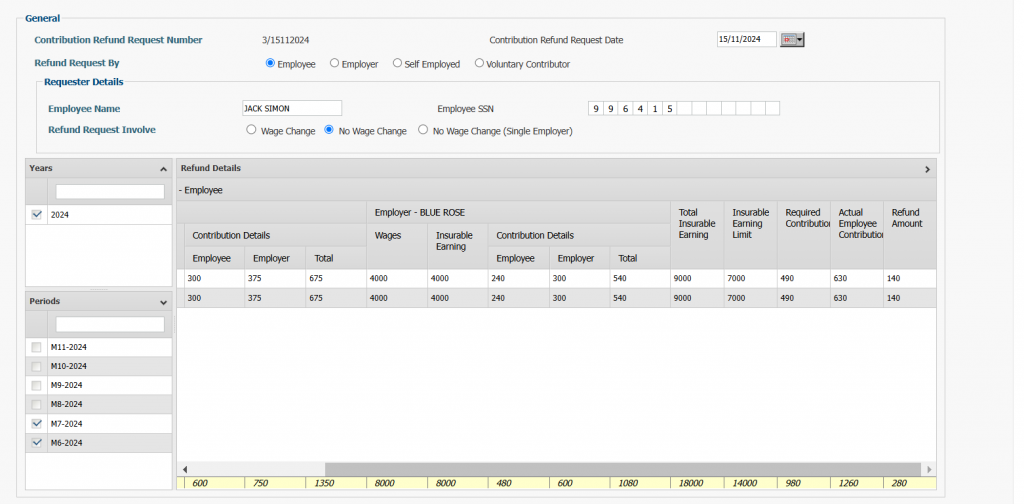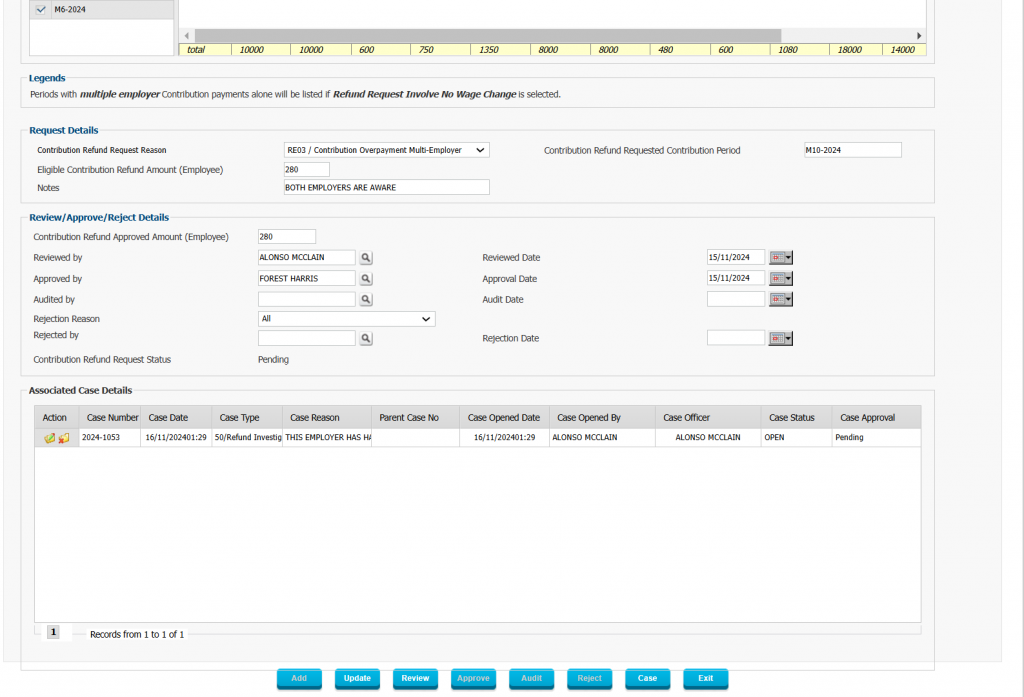Contribution Refunds in Social Security Administration: Multi-Employer Scenarios and Innovations in Interact SSAS
Contribution refunds are an essential mechanism in social security systems worldwide, ensuring that overpayments by contributors, employers, and voluntary participants are identified and rectified. These refunds maintain equity and compliance while addressing unique scenarios like those involving multiple employers or self-employed and voluntary contributors. This blog explores the role of contribution refunds in the United States and the United Kingdom, with a focus on cases involving multiple employers. We will also analyze how the Interact Social Security Administration System (SSAS) provides robust support for managing contribution refunds efficiently.
The Purpose of Contribution Refunds
Social security contributions are generally mandatory payments calculated based on income or specific thresholds set by governing bodies. Errors can occur in these calculations due to administrative mishandling, misreporting of earnings, or unique cases such as individuals working multiple jobs. Refunds act as a corrective tool to return excess contributions to the rightful payers, ensuring compliance with contribution limits and avoiding financial strain on contributors.
Common Scenarios Leading to Contribution Refunds
While contributions are designed to follow strict rules, discrepancies can arise. Below are some common cases where contribution refunds are necessary:
Overpayment by Employers
Employers may mistakenly overpay contributions for their employees, often due to payroll errors or misunderstanding of contribution thresholds. These overpayments are refunded once identified through internal audits or claims submitted by employers. Depending on the systems in place, if not enough controls exist to prevent incorrect calculations and/or if the employers or social security administration itself is still working partly with manual or paper-based processes, then such errors may still occur.
Overpayment by Self-Employed or Voluntary Contributors
Self-employed individuals or voluntary contributors calculate their contributions independently. Errors in income reporting, calculation methods, or duplicate payments may result in overpayment. For instance, a self-employed person might accidentally pay twice for the same income period or use outdated contribution rates.
Contributions from Multiple Employers Exceeding Limits
One of the most complex and frequent causes of overpayment occurs when employees work for multiple employers. Each employer calculates contributions independently, often leading to combined contributions exceeding statutory limits. Refunds in these scenarios ensure employees are not penalized for situations outside their control.
The U.S. Social Security System
In the U.S., the Social Security Administration (SSA) imposes an annual cap on taxable wages for Social Security contributions. For example, if the taxable wage base for 2024 is $160,200, contributions are calculated at 6.2% up to this limit. Each employer withholds contributions independently, potentially leading to overpayment when the employee’s total earnings from multiple jobs exceed the cap.
- Example: Suppose an employee earns $100,000 from Employer A and $100,000 from Employer B in a calendar year. Both employers withhold $6,200 (6.2% of $100,000). The combined contribution of $12,400 exceeds the statutory cap of $9,932.40 (6.2% of $160,200), resulting in an overpayment of $2,467.60.
- Resolution: Employees are entitled to claim the excess amount as a refund when filing their annual tax returns. The SSA processes the refund and adjusts the employee’s contribution record accordingly.
The U.K. National Insurance Contributions System
In the United Kingdom, National Insurance Contributions (NIC) function similarly. Employees earning above a certain threshold may find their combined contributions from multiple jobs exceeding the upper earnings limit.
- Example: An employee earns £60,000 annually from Job A and £50,000 from Job B. Both employers calculate NIC contributions independently, leading to combined contributions surpassing the annual limit. The excess can be refunded to the employee through a formal request to HM Revenue & Customs (HMRC).
- Resolution: HMRC either identifies the overpayment during routine checks or processes a refund upon request from the employee. Employees must provide proof of their total contributions and earnings across all employers to facilitate the refund.
Challenges in Multi-Employer Contribution Refunds
While refunds in multi-employer scenarios are straightforward in principle, several challenges complicate the process:
- Lack of Communication Between Employers:
- Employers are often unaware of an employee’s total earnings across other jobs, leading to independent and redundant calculations of contributions.
- Complexity in Verifying Refund Claims:
- Cross-referencing earnings and contributions from multiple sources can be administratively burdensome, particularly for manual systems.
- Delayed Refunds:
- Traditional systems may take months to process refund claims, leaving employees financially strained in the interim.
- Inconsistent Record Keeping:
- Discrepancies in payroll or reporting errors can further delay or invalidate refund claims.
Interact SSAS: A Modern Solution for Contribution Refunds
The Interact Social Security Administration System (SSAS) addresses the complexities of contribution refunds, particularly in multi-employer scenarios, by offering advanced automation, integration, and workflow management.
Key Features Supporting Refunds
Automated Overpayment Detection: The system tracks contributions in real time, comparing them against statutory limits. If contributions from multiple employers exceed the allowable cap, the system flags the excess and initiates the refund process automatically.
Streamlined Refund Workflows: Interact SSAS provides predefined workflows for refund requests. Employees or employers can submit refund claims online, specifying the period and reason for overpayment. The system routes these claims through approval hierarchies, ensuring compliance with social security policies.
Role-Based Approvals: Refund requests undergo role-based approvals, ensuring they are validated by appropriate authorities before processing. This reduces errors and fraud while maintaining accountability.
Integration with Payroll and Tax Systems: The system can be integrated with payroll and tax software using the SSAXML API, allowing it to gather earnings and contribution data seamlessly from multiple sources. This is particularly beneficial for multi-employer scenarios, where contribution data is fragmented.
Payment Flexibility: Refunds can be processed through ACH (Automated Clearing House) transfers or check printing, depending on the recipient’s preference. The system generates payment files automatically, ensuring timely disbursement.
Audit Trails: A complete audit trail is maintained for each refund request, showing the origin, approvals, and disbursements. This enhances transparency and simplifies reporting for compliance purposes.
Additional Functionality of Interact SSAS for Contribution Refunds
Interact SSAS offers a suite of tools to manage and streamline the refund process, including functionality specifically designed for cases involving overpayments in multi-employer scenarios. Here’s an expanded view of the system’s capabilities:
- Versatile Refund Initiation Options:
Refund requests can be initiated by various stakeholders, including employers, employees, voluntary contributors, and self-employed individuals. This flexibility ensures that all parties involved in the contribution process have a straightforward method to address overpayment scenarios. - Support for Diverse Scenarios:
Interact SSAS distinguishes between refund cases involving wage changes and those without wage changes. In particular, it handles:- Cases where wage adjustments lead to overpayments.
- Single-employer overpayment scenarios.
- Multi-employer cases where combined contributions exceed statutory limits, ensuring these complex situations are managed effectively.
- Reason Configuration for Refunds and Adjustments:
The system allows for the configuration of reasons for both adjustments and refunds. This includes setup options for rejection reasons, ensuring that every request is well-documented and any denials are clearly justified. These configurations ensure consistency in handling similar cases. - Notes and Case Tracking:
Interact SSAS includes functionality for tracking notes related to refund requests. Administrators can document specific details, decisions, and follow-up actions. Additionally, the system supports the creation of cases linked to refund requests, providing a formalized structure for investigation and resolution.
This functionality underscores the system’s adaptability and its commitment to addressing the complexities of contribution refunds in both single- and multi-employer contexts. By integrating these tools, Interact SSAS enhances administrative efficiency, ensures compliance, and provides transparency throughout the refund process.
Case Study: Multi-Employer Refund with Interact SSAS
Consider an employee in the Caribbean working for two employers, each paying 5,000 in monthly wages. Here’s how Interact SSAS manages the refund process:
- Data Aggregation:
- Contributions from each employer are recorded in real-time. The system aggregates these figures to calculate total contributions for the employee.
- Overpayment Detection:
- The system identifies that the combined contributions exceed the statutory cap for the year. For instance, total monthly earnings of 10,000 result in contributions of 600, while the maximum insurable earnings are 7,000 per month, which means that the contributions should have been capped at 420.
- Refund Workflow:
- A refund request can be initiated by the employee for the excess 180. The system will automatically calculate the difference in contribution as a result of the overpaid amounts caused by the multiple employer scenario. The request is routed to the appropriate SSA officer and flagged for review and approval.
- Approval and Disbursement:
- The claim is reviewed and approved by the relevant social security authority. The system generates an ACH file for the refund, transferring the amount directly to the employee’s account.
- Record Updates:
- The employee’s contribution record is updated to reflect the corrected amount, ensuring compliance and accurate future calculations.
Benefits of Interact SSAS for Contribution Refunds
Accuracy: Automated calculations and validations reduce errors in detecting overpayments and processing refunds.
Efficiency: Streamlined workflows and real-time processing significantly reduce the time required for refunds, ensuring faster resolution.
Transparency: Comprehensive audit trails and notifications keep all stakeholders informed throughout the process.
Flexibility: The system supports diverse scenarios, including self-employed contributions, voluntary payments, and multi-employer overpayments.
Integration: Seamless integration with payroll, tax, and general ledger systems ensures accurate data flow and financial reporting.
Conclusion
Contribution refunds are a vital component of social security administration, safeguarding contributors from overpayment and ensuring compliance with regulatory limits. Multi-employer scenarios present unique challenges, but systems like Interact SSAS offer innovative solutions to manage these complexities. By automating overpayment detection, streamlining workflows, and integrating with payroll systems, Interact SSAS revolutionizes the way refunds are processed. Whether handling self-employed contributions or managing multi-employer overpayments, this system delivers accuracy, efficiency, and transparency for modern social security administrations.


